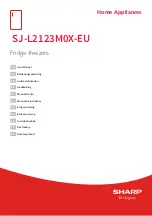
EN -7-
CHAPTER -3: USING YOUR FRIDGE FREEZER
Warnings for temperature settings
•
The ambient temperature, temperature of the freshly stored food and how often the door is opened, affects the
temperature in the refrigerator compartment. If required,change the temperature setting.
•
It is not recommended that you operate your fridge in environments colder than 10°C .
•
The thermostat setting should be set by taking into consideration how often the fresh food and freezer doors
are opened and closed, how much food is stored in the refrigerator and the environment in which and the
positioning of the appliance.
• We recommend that when first using the fridge freezer it should be left running for 24 hours uninterrupted to
ensure it is completely cooled . Do not open the fridge doors, or put food inside for this period.
•
Your fridge freezer has a 5 minute built in delay function, designed to prevent damage to the compressor. When
power is applied to your fridge freezer, it will begin to operate
normally after 5 minutes.
•
Your fridge is designed to operate in the ambient temperature
intervals stated in the standards, according to the climate class
stated in the information label. It is not recommended that your
fridge is operated in the environments which are out of the
stated temperature intervals in terms of cooling efficiency.
•
This appliance is designed for use at an ambient tem-perature
within the 16°C - 32°C range.
Climate Class Ambient Temperature
o
C
T
Between 16 and 43 (°C)
ST
Between 16 and 38 (°C)
N
Between 16 and 32 (°C)
SN
Between 10 and 32 (°C)
Temperature indicator
In order to help you better set your refrigerator, we have equipped it with a temperature indicator located in
the coldest area.
To better store the food in your refrigerator, especially in the coldest area, make sure the message “OK”
appears on the temperature indicator. If « OK » does not appear, this means temperature has not been set
properly
It may be difficult to see the indicator, make sure it is properly lit.Each time the temperature setting device is
changed, wait for the stabilisation of the temperature inside the appliance before proceeding, if necessary,
with a new temperature setting. Please change the position of the temperature setting device progressively and wait at
least 12 hours before starting a new check and potential change.
NOTE:
Following repeated openings (or prolonged opening) of the door or after putting fresh food into the appliance,
it is normal for the indication “OK” not to appear in the temperature setting indicator. If there is an abnormal build up
of ice crystals of ice crystals (bottom wall of the appliance) on the refrigerator compartment, evaporator (overloaded
appliance, high room temperature, frequent door openings), put the temperature setting device on a lower position until
compressor off periods are obtained again.
Store food in the coldest area of the refrigerator.
Your foods will be better stored if you put them in the most appropriate
cooling area. The coldest area is just above the crisper.
The following symbol indicates the coldest area of your refrigerator.
To be sure to have a low temperature in this area, make sure the shelf is
located at the level of this symbol, as shown in the illustration.
The upper limit of the coldest area is indicated by the lower side of the sticker (head of
the arrow). The coldest area upper shelf must be at the same level with the arrow head.
The coldest area is below this level.
As these shelves are removable, make sure they are always at the same level with these
zone limits described on the stickers, in order to guarantee temperatures in this area.
OK
“Door Open” Indicator;
•
The “Door Open” indicator on the lock slide indicates whether the door
is closed properly or not.
•
If the red indicator is visible, the door is still open.
•
If the red indicator is invisible, the door is properly closed.
•
Observe that the freezer door should always be kept closed properly.
This will prevent food inside the freezer from defrosting; it will avoid
heavy ice and frost build-up inside the freezer and an unnecessary
increase in energy consumption.









































